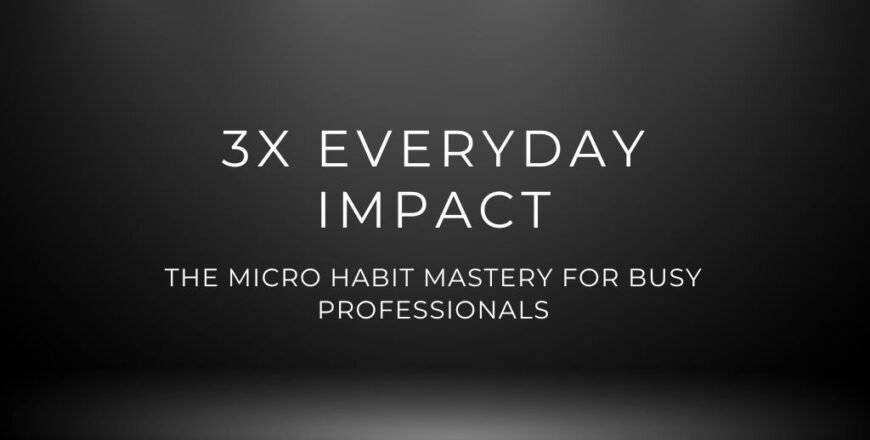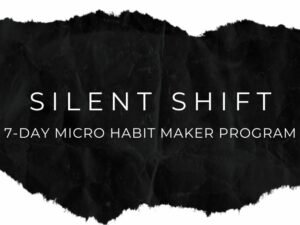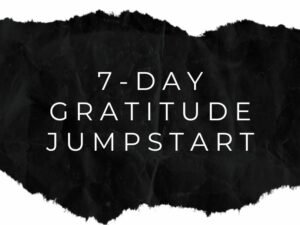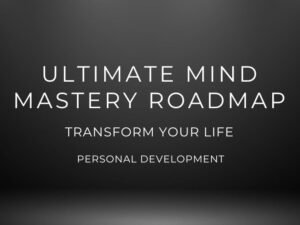3X Everyday Impact—The Micro Habit Mastery for Busy Professionals
- Description
- Curriculum
- Reviews
Welcome to 3X Everyday Impact—The Micro Habit Mastery for Busy Professionals
Hey there! Are you ready to flip the script on your day and take control like never before? Imagine transforming every hectic, stress-filled moment into a powerhouse of productivity and balance—without burning out. This isn’t about adding more to your already overloaded plate; it’s about making tiny, deliberate changes that add up to massive, lasting impact.
A Fresh Start for a Better You
I’m thrilled that you’re here because I know what it’s like to feel overwhelmed by endless work and constant distractions. You deserve a life where every minute counts and where you can finally say, “I’m in charge.” In this course, we’re cutting through the noise with straightforward, actionable strategies that help you build the micro habits necessary for real change. This is your invitation to step into a new era of work-life balance, where you not only crush your professional goals but also reclaim the joy of your personal time.
Here’s What’s in There
You’ll discover how to:
- Own Your Day: Learn simple, powerful habits that anchor your daily schedule and help you hit your top priorities.
- Protect Your Time: Establish clear boundaries to ensure your personal life isn’t sacrificed for work.
- Advance Your Career: Build and refine skills that push your professional journey forward without overwhelming you.
- Eliminate Distractions: Identify and replace bad habits that are holding you back, using proven, practical tools.
- Reflect and Grow: Use a dedicated journal and worksheets to track your progress, celebrate wins, and adapt as needed.
Let’s Get Real
This course isn’t about fancy theories or lofty promises. It’s about real, tangible steps that you can take right now—even if you have the busiest schedule. I’m here to guide you, every step of the way, with down-to-earth advice that’s designed to fit into your life seamlessly. Think of it as your personal roadmap to reclaiming your time, your energy, and your future.
So, if you’re ready to stop feeling stuck and start making every day count, welcome aboard. Get set to unleash your inner powerhouse and transform your life—one micro habit at a time.
Course Structure and How to Go About It
Now that you’re here and ready to transform your day, let’s break down exactly how this 3X Everyday Impact—The Micro Habit Mastery for Busy Professionals course is structured and how you can make the most of every lesson.
How the Course is Structured
This course is divided into two main parts to address every aspect of your professional and personal growth:
Part I: Achieving Your Professional Goals
- Modules for Goal Achievement:
In these modules (from 1 to 10), you’ll focus on key areas such as time management, work-life balance, career advancement, stress reduction, productivity, communication, digital skills, decision-making, personal branding, and financial stability. Each module dives deep into a specific goal with its own set of lessons, actionable micro habits, and practical exercises. - Actionable Lessons:
Every module is broken into lessons that introduce a core concept, demonstrate how to implement micro habits, and provide worksheets and journaling prompts to guide you. For example, you’ll learn to map out your career progression with a Mastery Roadmap Planner or set clear daily priorities with a Micro Habit Planner.
Part II: Overcoming Common Bad Habits
- Modules for Breaking Bad Habits:
This part (modules from 11 to 20) tackles the common pitfalls busy professionals face, such as overworking, poor time management, inefficient multitasking, neglecting self-care, reluctance to delegate, blurred boundaries, digital distractions, procrastination on personal interests, overcommitting, and skipping professional development. - Actionable Strategies:
Each module in this section uses our Bad Habit Analysis Template to help you identify and understand what’s holding you back. You’ll then learn to replace these negative behaviors with effective, easy-to-adopt micro habits. Practical exercises, reflective prompts, and real-world examples make the process tangible and relatable.
How to Go About the Course
1. Start at Your Own Pace
- Begin with Module 1: Dive into the fundamentals of time management. Each module builds on the previous one, so it’s best to start at the beginning.
- Progress Sequentially: Follow the course modules in order, but feel free to revisit any lesson if you need a refresher. The course is designed to be flexible and accommodate your busy schedule.
2. Engage with Every Resource
- Workbooks and Journal: Make sure to use the Silent Revolution Workbook and Journal provided. They are packed with worksheets, planners, and reflection prompts that transform theory into actionable steps.
- Cross-References: Some modules include cross-references to others (for example, how effective time management supports work-life balance). Use these pointers to see the bigger picture of how micro habits interlink to create a powerful, holistic system.
3. Take Action Daily
- Implement Micro Habits: Each lesson includes specific, simple actions (like a 3-minute morning planning ritual or a 10-minute shutdown ritual). These micro habits are designed to be easily integrated into your day without overwhelming you.
- Journal Your Progress: Daily and weekly journaling is critical. Log your successes, note any challenges, and adjust your approach. This reflection not only reinforces learning but also keeps you accountable.
4. Review and Reflect
- Weekly and Monthly Reviews: Use the provided worksheets to track your progress over time. Reflect on your accomplishments and areas that need tweaking. This ongoing evaluation helps you fine-tune your habits and ensures continuous improvement.
- Celebrate Small Wins: Recognize every step forward—no matter how small. Each micro habit you successfully adopt builds the foundation for bigger changes.
5. Stay Connected and Motivated
- Join the Community: (Under Process) Engage with other course participants on our platform, share your journey, and learn from their experiences. This support network is invaluable as you work toward your goals.
- Access Additional Resources: If you need deeper insights or extra motivation, consider exploring the main book, additional workbooks, and journal. These resources are designed to supplement your learning and provide ongoing support.
Key Takeaways
- Structured Learning: The course is divided into clear modules focusing on both professional goals and overcoming bad habits.
- Practical Tools: You’ll receive actionable micro habits, worksheets, and journaling prompts that make the process hands-on and effective.
- Daily and Reflective Practices: Implement daily micro habits and regularly review your progress to build sustainable change.
- Holistic Growth: By addressing both positive goals and negative habits, you create a balanced, thriving professional and personal life.
Time Requirements
- Daily Lesson Engagement: Approximately 15-20 minutes per day, including reading content and completing exercises.
- Daily Practice Time: About 15-20 minutes for implementing micro habits (this varies per module).
- Weekly/Monthly Reflection: Approximately 10-15 minutes per week/month for deeper reflection and planning.
-
Phased Approach
- Rather than try to complete all 20 modules at once, many find success focusing on one or two modules per week, absorbing the lesson content and initial steps (~40–50 minutes) before practicing the daily habit (~5–10 min each day).
-
Weekly/Monthly Check-Ins
- With multiple micro habits in play, schedule a short monthly review (~10–15 minutes) to evaluate which habits are thriving and which need refinement.
-
Long-Term Routine
- Over a few months, you’ll have addressed all modules, while the daily practice ensures your new, healthier work habits stick.
Although it may sound significant, the course is designed for incremental progress: you spend an hour or so each time you tackle a new module, then maintain a small daily routine. The total course time might approach 7 hours total learning and intotal ~15 hours plus daily practice, but it’s spread out to avoid overload and keep your professional growth steady and sustainable.
This course is designed for busy professionals like you who are ready to make a real impact in their lives—one small habit at a time. Follow the modules sequentially, engage with every tool provided, and let the transformation begin.
Your journey to greater balance, productivity, and success starts now. You’ve got this!
-
1Lesson 1.1: The Power of Micro Habits for Time Management10 Minutes
Discover how tiny, consistent actions can overhaul your chaotic schedule. Learn to streamline your day by adopting simple daily routines that eliminate guesswork, reduce overwhelm, and keep you aligned with top priorities—one small step at a time.
-
2Lesson 1.2: Advanced Time-Blocking Techniques10 Minutes
Uncover practical methods to block your schedule into clear, productive segments. By strategically placing buffers and focus periods, you’ll transform each workday into a structured, efficient plan, ensuring less frantic multitasking and better results.
-
3Example Exercises8 Minutes
Below are two sample exercises that illustrate how to effectively use the "Plan Your Day" and "Daily Check-In Reflection" pages in your Silent Revolution Journal. These examples are designed to give you a clear picture of how to integrate these practices into your daily routine, reinforcing your micro habits for improved time management and overall productivity.
-
4Lesson 2.1 – Establishing Clear Boundaries and Shutdown Rituals10 Minutes
Learn a step-by-step approach to fully disconnecting once work ends. With daily shutdown rituals, you’ll guard personal time, decompress effectively, and prevent lingering tasks from creeping into evenings or weekends.
-
5Lesson 2.2: Tracking Your Personal vs. Work Time8 Minutes
Discover a simple method to log how your day divides between professional duties and personal activities. Identifying imbalances helps you regain control, ensuring you don’t unwittingly sacrifice rest or relationships for endless work.
-
6Example Exercises8 Minutes
Explore sample daily trackers showing how others balanced intense project deadlines and family commitments. Observe how small boundary-setting habits turned hectic routines into more sustainable, guilt-free schedules.
-
7Lesson 3.1: Mapping Your Career Progression10 Minutes
Chart your long-term growth with clear milestones. Whether aiming for a promotion or pivoting industries, you’ll plot actionable goals and break them into micro steps, transforming lofty dreams into an achievable professional roadmap.
-
8Lesson 3.2: Daily Skill-Building and Networking10 Minutes
Commit 15 minutes each day to learn a new skill or forge a professional connection. Tiny efforts compound, boosting your expertise and expanding your network, paving the way for meaningful career leaps without overwhelming your schedule.
-
9Example Exercises8 Minutes
See how busy professionals allocated small pockets of time for specialized training and targeted LinkedIn outreach. Their stories illustrate how consistent skill-building and networking can rapidly elevate your career trajectory.
-
10Lesson 4.1: Quick Stress-Relief Micro Habits10 Minutes
Master mini stress-busters like brief meditations, breathing exercises, or stretches that instantly calm frayed nerves. These short, repeated breaks keep you resilient under pressure, stopping tension before it overwhelms you.
-
11Lesson 4.2: Long-Term Stress Management Strategies10 Minutes
Learn to spot ongoing stress triggers and address them proactively. By reflecting daily or weekly, you’ll adjust routines, tasks, or boundaries to maintain steady mental health, preserving energy and focus over the long haul.
-
12Example Exercises8 Minutes
Explore real scenarios showing how a few deep-breathing sessions or daily decompression rituals significantly lowered stress. Observe how professionals inserted tiny stress relievers into intense days without disrupting workflow.
-
13Lesson 5.1: The Art of Focused Work10 Minutes
Discover why short, distraction-free work sprints outperform multitasking marathons. You’ll learn to commit fully to one task at a time, finishing it faster and with higher quality, all while cutting stress and error rates.
-
14Lesson 5.2: Leveraging Micro Habits to Maximize Output10 Minutes
Explore how small, daily routines—like a 2-minute planning session or quick desk declutter—dramatically streamline tasks and curb lost time. Consistent micro habits keep your day proactive, not reactive, boosting output effortlessly.
-
15Example Exercises8 Minutes
See how a project manager balanced multiple deadlines by mixing “deep work” intervals with short micro habits like daily desk resets. Learn how these examples apply across diverse roles and project complexities.
-
16Lesson 6.1: Enhancing Clarity and Listening10 Minutes
Elevate both spoken and written communication by simplifying your message and tuning into others’ viewpoints. Active listening techniques help you grasp nuances, leading to more constructive dialogues and fewer misunderstandings.
-
17Lesson 6.2: Expressing Your Ideas Confidently10 Minutes
Adopt short daily exercises for assertive messaging—like refining emails or practicing verbal pitches. Over time, these drills give you the clarity, structure, and confidence to be heard and respected in any professional setting.
-
18Example Exercises8 Minutes
Walk through sample communication exercises: from writing concise action plans to delivering brief meeting updates. Observe how consistent practice boosts clarity and persuasiveness in everyday work interactions.
-
19Lesson 7.1: Embracing New Technologies10 Minutes
Identify how avoiding new tools or software leaves you behind. By dedicating small blocks to learning advanced features or emerging apps, you’ll adapt more quickly and maintain a competitive edge in your field.
-
20Lesson 7.2: Practical Digital Efficiency Hacks10 Minutes
Implement one tech shortcut each week—like keyboard macros, streamlined email filters, or quick automation. These minor tweaks trim wasted clicks and routine tasks, raising your efficiency without extra labor.
-
21Example Exercises8 Minutes
Discover how professionals introduced one new digital hack (like auto-filing emails) each week. Their real-world experiences highlight saved minutes that accumulate into significant monthly time gains.
-
22Lesson 8.1: Quick Decision-Making Frameworks10 Minutes
Adopt simple steps—like a short checklist or “pros/cons”—that help you avoid overthinking. Learn how to quickly evaluate data, weigh stakes, and pick a path with confidence, keeping analysis paralysis at bay.
-
23Lesson 8.2: Reflecting on Decision Outcomes10 Minutes
Develop a habit of briefly reviewing each major decision in a journal. This systematic approach helps refine your instincts, reveal blind spots, and cultivate a smoother decision-making style for future choices.
-
24Example Exercises8 Minutes
Explore example frameworks where executives used rapid “gut-checks” or daily reflection logs to sharpen decisions. Their experiences show how iterative improvements lead to better calls under tight deadlines.
-
25Lesson 9.1: Defining Your Unique Value10 Minutes
Pinpoint your defining strengths, values, and expertise. Learn to craft a concise, authentic brand statement that sets you apart professionally, showcasing what you offer beyond just a job title.
-
26Lesson 9.2: Promoting Your Brand Consistently10 Minutes
Spend 5 minutes daily refining online profiles, sharing insights, or engaging in relevant communities. Small, regular actions let your brand grow steadily, earning trust and recognition over time.
-
27Example Exercises10 Minutes
Examine how professionals polished their LinkedIn headlines or wrote quick thought-leadership posts each day. Their brand visibility soared without investing huge blocks of time.
-
28Lesson 10.1: Establishing a Financial Routine10 Minutes
Implement a quick daily check on balances, expenses, and budgets to protect your long-term wealth. Simple, steady habits—like daily expense logs—avert surprise bills and ballooning debts.
-
29Lesson 10.2: Planning for Long-Term Financial Health10 Minutes
Define major monetary milestones (like an emergency fund or home down payment) and pair them with micro habits. Over time, consistent small steps guide you toward a secure, stress-free financial outlook.
-
30Example Exercises8 Minutes
Watch how pros systematically built emergency funds by transferring small sums each day and reconciling budgets weekly. Their example shows how micro habits make big money goals attainable.
-
31Lesson 11.1: Recognizing the Cost of Overwork10 Minutes
Identify how relentless work drains health and leads to mistakes. Map out where you’re pushing too far and add realistic rest points to keep performance sustainable.
-
32Lesson 11.2: Implementing Micro Breaks10 Minutes
Insert short, strategic pauses—like a 5-minute stretch or water break—throughout the day. These pockets of recovery prevent burnout and sharpen your attention.
-
33Example Exercises8 Minutes
See real schedules where people integrated small breaks every two hours, noticing a swift drop in fatigue. These examples encourage you to adopt micro recoveries without slashing productivity.
-
34Lesson 12.1: Identifying Time-Wasting Patterns10 Minutes
Unearth hidden schedule leaks—like unplanned social media or random “quick tasks” that linger. Analyze them to reclaim crucial minutes and reduce daily chaos.
-
35Lesson 12.2: Building a Micro Habit for Time Management10 Minutes
Replace frantic mornings with a 3-minute “Plan My Day” routine. These short prep sessions guide your tasks, so you tackle them with purpose instead of drifting in reactive mode.
-
36Example Exercises10 Minutes
Explore diaries of professionals who implemented daily planning rituals, discovering how 3-minute logs saved hours of scattered effort across the week.
-
37Lesson 13.1: The Pitfalls of Multitasking10 Minutes
Discover why juggling tasks kills deep focus and degrades work quality. Learn how to consolidate tasks and reduce mental switching for a more efficient flow.
-
38Lesson 13.2: Embracing Focused Work Sessions10 Minutes
Adopt brief, single-task sprints (like 15-minute blocks) and track them. You’ll see how harnessed concentration speeds completion and cuts error rates.
-
39Example Exercises10 Minutes
Check out sample “sprint logs” from busy team leads who dropped multitasking for short bursts of deep work, enjoying faster, more accurate output.
-
40Lesson 14.1: Recognizing the Impact of Poor Self-Care10 Minutes
See how inconsistent meals, lack of exercise, or minimal rest sabotage both body and mind. Map these blind spots to reverse mounting fatigue or sluggishness.
-
41Lesson 14.2: Integrating Self-Care Micro Habits10 Minutes
Choose a small daily well-being practice—like a 2-minute stretch or mindful hydration—and log it. Frequent mini self-care moments buffer stress and re-energize you.
-
42Example Exercises10 Minutes
Real employees share how short midday walks or bedtime wind-downs rescued them from burnout. Their progress highlights the power of micro steps for lasting health.
-
43Lesson 15.1: Understanding the Cost of Doing It All10 Minutes
Spot how clinging to every task causes errors, fatigue, and missed deadlines. Analyze the underlying fears blocking delegation, unlocking a path to shared workloads.
-
44Lesson 15.2: Establishing a Daily Delegation Habit10 Minutes
Assign one task a day to a colleague or team member, tracking each in your planner. Gradually reducing your load boosts efficiency and empowers others.
-
45Example Exercises10 Minutes
Peer stories show how daily, small-scale delegation built trust and freed leaders for bigger initiatives. They found it simpler than expected once they overcame the initial fear.
-
46Lesson 16.1: The Consequences of Blurred Boundaries10 Minutes
Discover how letting work spill into personal hours ramps up stress and damages relationships. Use a template to trace where lines get crossed and make corrective changes.
-
47Lesson 16.2: Creating a Shutdown Ritual for Clear Boundaries10 Minutes
Adopt a 10-minute end-of-day routine (like closing out tasks, logging tomorrow’s plan) to officially switch off. Track it in your planner so personal time stays sacred.
-
48Example Exercises10 Minutes
Samples of evening shutdown checklists illustrate how a brief daily closure revitalized family life and cut mental carryover of work into nights.
-
49Lesson 17.1: Identifying Digital Time Sinks10 Minutes
Pinpoint how endless pings, social feeds, and notifications gobble up your focus. Analyzing these patterns reveals easy fixes (like muting or scheduled checks).
-
50Lesson 17.2: Implementing Device-Free Focus Blocks10 Minutes
Carve out a 15-minute window where all devices go silent. Log these mini digital detoxes in your habit tracker, noticing how real concentration resurfaces.
-
51Example Exercises10 Minutes
See how daily 15-minute “offline” intervals drastically cut wasted screen time for busy professionals, helping them complete tasks faster and more accurately.
-
52Lesson 18.1: The Hidden Cost of Neglected Passions10 Minutes
Realize how constantly shelving hobbies dampens motivation and creativity. Use templates to see how ignoring personal pursuits might be hurting your morale and performance.
-
53Lesson 18.2: Building a Daily Hobby Micro Habit10 Minutes
Dedicate 10 minutes to a cherished pastime (reading, playing an instrument, or crafting). Log each session in your journal, turning small joys into daily rejuvenation.
-
54Example Exercises10 Minutes
Everyday examples show how micro hobby sessions recharge busy employees, fueling fresh ideas at work while restoring personal excitement.
-
55Lesson 19.1: The Danger of Taking on Too Much10 Minutes
Spot how accepting every request leads to scattered focus and subpar work. Use the template to break the “yes” habit, learning that strategic refusals guard your energy.
-
56Lesson 19.2: Implementing a 60-Second “Priority Check”10 Minutes
Pause for one minute before agreeing to new tasks. This micro habit stops reflex “yeses,” letting you assess alignment with your goals and avoid overload.
-
57Example Exercises10 Minutes
Peer experiences reveal how short priority checks saved them from drowning in tasks, preserving mental clarity and ensuring they kept critical commitments.
-
58Lesson 20.1: Recognizing the Value of Continuous Learning10 Minutes
See how missing training or skills refreshers stalls career momentum. Use a template to list overlooked learning chances, motivating you to seize the next one.
-
59Lesson 20.2: Establishing a Daily Learning Micro Habit10 Minutes
Spend 10 minutes a day—reading an article, watching a tutorial, or reviewing a new tool. Track progress to build a consistent learning streak, fueling long-term expertise.
-
60Example Exercises10 Minutes
Examples show how small daily commitments (like listening to a short industry podcast) steadily sharpened professionals’ competitive edge, all with minimal time investment.




